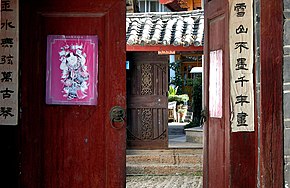
Back شعر صيني Arabic Κινεζική ποίηση Greek Poesía china Spanish شعر چینی Persian Poésie chinoise French Poesía chinesa Galician Kínai költészet Hungarian Puisi Tionghoa ID Chinese poetry Malay Китайская поэзия Russian


Chinese poetry is poetry written, spoken, or chanted in the Chinese language, and a part of the Chinese literature. While this last term comprises Classical Chinese, Standard Chinese, Mandarin Chinese, Yue Chinese, and other historical and vernacular forms of the language, its poetry generally falls into one of two primary types, Classical Chinese poetry and Modern Chinese poetry.[1][2]
Poetry is consistently held in high regard in China, often incorporating expressive folk influences filtered through the minds of Chinese literati.[3] Poetry provides a format and a forum for both public and private expressions of deep emotion, offering an audience of peers, readers, and scholars insight into the inner life of Chinese writers across more than two millennia.[4] Chinese poetry often reflects the influence of China's various religious traditions.[5]
Classical Chinese poetry includes, perhaps first and foremost shi (詩/诗), and also other major types such as ci (詞/词) and qu (曲). There is also a traditional Chinese literary form called fu (賦/赋), which defies categorization into English more than the other terms, but perhaps can best be described as a kind of prose-poem.[2] During the modern period, there also has developed free verse in Western style. Traditional forms of Chinese poetry are rhymed, but the mere rhyming of text may not qualify literature as being poetry; and, as well, the lack of rhyme would not necessarily disqualify a modern work from being considered poetry, in the sense of modern Chinese poetry.[1]
- ^ a b Greene 2012a.
- ^ a b Greene 2012b.
- ^ Greene 2012c.
- ^ Cai 2008, pp. xxi, 1.
- ^ Williams 2022.